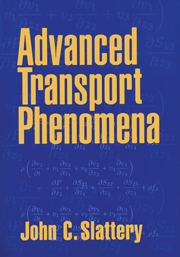Book contents
- Frontmatter
- Contents
- Preface
- List of Notation
- Advanced Transport Phenomena
- 1 Kinematics
- 2 Foundations for Momentum Transfer
- 3 Differential Balances in Momentum Transfer
- 4 Integral Averaging in Momentum Transfer
- 5 Foundations for Energy Transfer
- 6 Differential Balances in Energy Transfer
- 7 Integral Averaging in Energy Transfer
- 8 Foundations for Mass Transfer
- 9 Differential Balances in Mass Transfer
- 10 Integral Averaging in Mass Transfer
- A Tensor Analysis
- B More on the Transport Theorem
- References
- Author/Editor Index
- Index
5 - Foundations for Energy Transfer
Published online by Cambridge University Press: 05 June 2012
- Frontmatter
- Contents
- Preface
- List of Notation
- Advanced Transport Phenomena
- 1 Kinematics
- 2 Foundations for Momentum Transfer
- 3 Differential Balances in Momentum Transfer
- 4 Integral Averaging in Momentum Transfer
- 5 Foundations for Energy Transfer
- 6 Differential Balances in Energy Transfer
- 7 Integral Averaging in Energy Transfer
- 8 Foundations for Mass Transfer
- 9 Differential Balances in Mass Transfer
- 10 Integral Averaging in Mass Transfer
- A Tensor Analysis
- B More on the Transport Theorem
- References
- Author/Editor Index
- Index
Summary
This chapter is concerned with the foundations for energy transfer. And yet perhaps that is not sufficiently descriptive of what we are actually going to do here, because the foundations for energy transfer are really the foundations for the subject we normally think of as thermodynamics.
By thermodynamics, we do not mean precisely the subject presented to us by Gibbs (1928), since he was concerned with materials at equilibrium. We are concerned here with nonequilibrium situations in which momentum and energy are being transferred. (Don't make the mistake of confusing the terms steady state and equilibrium.)
There are at least two points to note.
1) Rather than a balance equation for entropy, we have an inequality: the entropy inequality or second law of thermodynamics.
2) There are two forms for the entropy inequality. The sole purpose of the differential entropy inequality is to place restrictions upon descriptions of material behavior: constitutive equations for specific internal energy (the fundamental equation of state relating specific internal energy and specific entropy), for the stress tensor, for the energy flux vector,… The integral entropy inequality, which will be developed in Section 7.4.4, is more familiar to most readers, since it is generally the only form mentioned in undergraduate texts on thermodynamics.
Energy
Energy Balance
We think that you will be better able to visualize our next step if you consider for a moment a particulate model of a real material. The molecules are in relative motion with respect to the material that they comprise. They have kinetic energy associated with them beyond the kinetic energy of the material as a whole.
Information
- Type
- Chapter
- Information
- Advanced Transport Phenomena , pp. 250 - 282Publisher: Cambridge University PressPrint publication year: 1999
